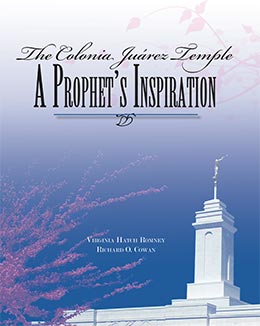The Temple's Open House
Virginia Hatch Romney and Richard O. Cowan, The Colonia Juárez Temple: A Prophet’s Inspiration (Provo, UT: Religious Studies Center, Brigham Young University, 2009), 89-103.
The general feeling among the members in the colonies was still one of disbelief, even though the temple was now completed. Rea Schmidt from Colonia Juárez said, “It’s still like a dream, one I hope I never wake up from.” Wesley Bowman from Colonia Dublán agreed: “It’s a miracle. We never dreamed we would have such a beautiful temple.”[1] Still, the temple’s dedication and accompanying open house could not take place without extensive preparation.
Planning and Preparation
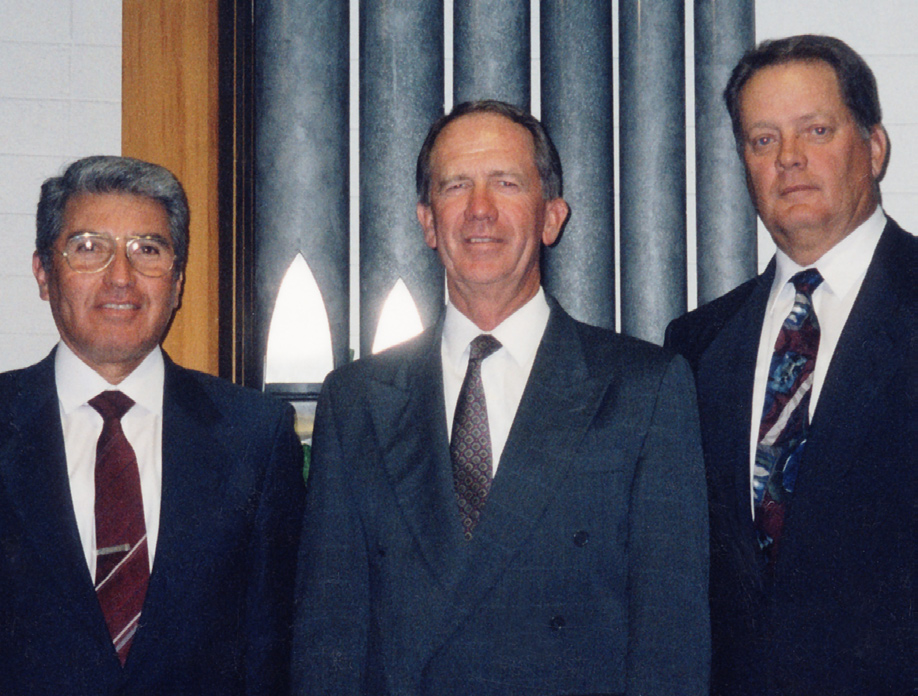 Left to right: Victor M. Cerda, John B. Robinson, and Meredith I. Romney.
Left to right: Victor M. Cerda, John B. Robinson, and Meredith I. Romney.
Planning for the temple’s open house and dedication had occurred throughout the time the temple was under construction. In early March 1998, about the time of the temple groundbreaking, John B. Robinson, a former stake and mission president and future temple president from Colonia Dublán, received a surprise phone call from President Gordon B. Hinckley. The prophet called him to be chairman of the local open house and dedication committee. He learned that Elder Eran Call, president of the Mexico North Area, was responsible for planning these events and that the local chairman would receive direction from him as well as from the Temple Department in Salt Lake City. His contact at Church headquarters would be Jack Purser. “Even though I seemed to have two bosses,” Brother Robinson reflected, “there was never any conflict or differences in the instructions. Both the Temple Department and the local committee recognized Elder Call’s authority and followed his instructions. If he was not aware of the circumstances concerning a decision that needed to be made, he would ask for our opinion and generally follow it.”
Brother Robinson received a book outlining in minute detail the procedures to be followed at the groundbreaking (which had already taken place), open house, cornerstone laying, and temple dedication. He therefore spent considerable time and effort in learning his responsibilities for these last three events. He discovered that there were to be twelve subcommittees working under his direction. “It was surprising for me to see so much detail outlined,” he reflected, “as there was a section for each of these subcommittees with each one having many details to carry out.”
Because John Robinson had served as a leader when there was just one stake, he knew many of the members in both of the existing stakes. In selecting committee chairmen, he drew from both stakes, seeking balance between cultures and including both men and women. “In choosing the heads for these subcommittees, I worked with both stake presidents and came up with suggestions for possible candidates,” Brother Robinson recalled. “As I prayed and visited time and again with each of the stake presidents and Elder Call, it became clear to me who the Lord wanted in these positions.”[2]
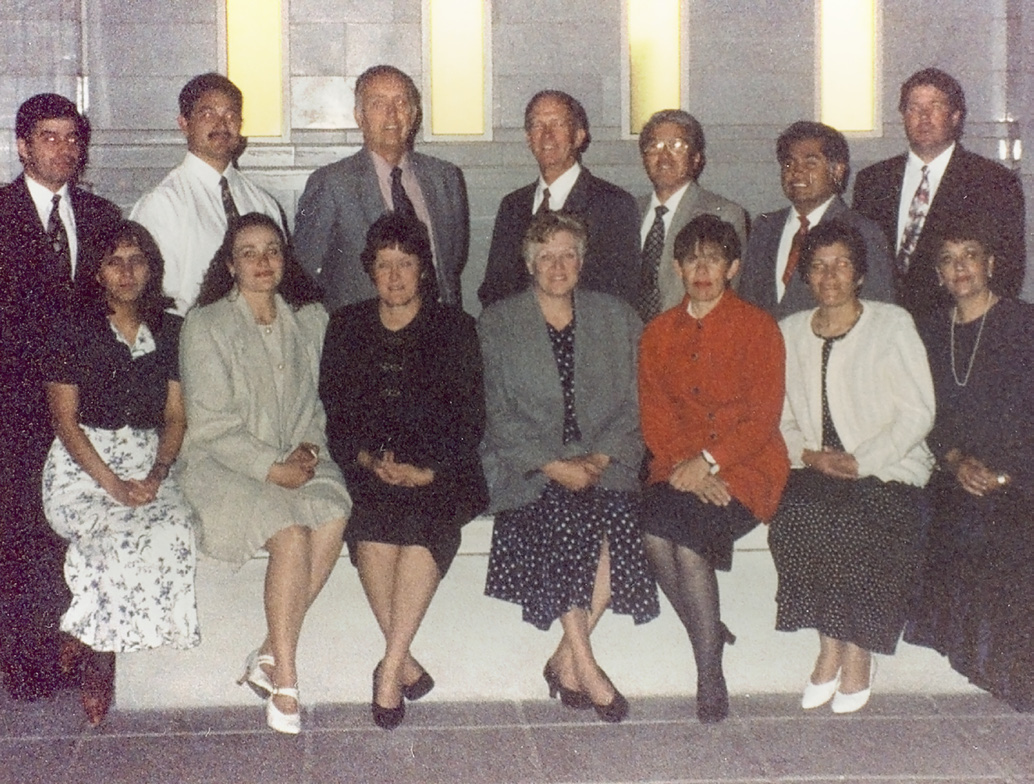 Subcommittee chairs played key roles in preparing for the temple’s open house and dedication, left to right: Aaron and Araceli Chavez, Horacio and Carmen Peña, Kent and Virginia Romney, John and Ellen Robinson, Victor and Yolanda Cerda, Joel and Sara Haydee de la Cruz, Frank Hatch, and Aurora Nielsen.
Subcommittee chairs played key roles in preparing for the temple’s open house and dedication, left to right: Aaron and Araceli Chavez, Horacio and Carmen Peña, Kent and Virginia Romney, John and Ellen Robinson, Victor and Yolanda Cerda, Joel and Sara Haydee de la Cruz, Frank Hatch, and Aurora Nielsen.
Each chairman was approved by Elder Call and Brother Purser. Previous experience led Church leaders to recommend that stake presidents personally head three of the subcommittees. Therefore President Victor M. Cerda of the Colonia Dublán Stake received responsibility for the member missionary and music subcommittees, and President Meredith I. Romney of the Colonia Juárez Stake was assigned to head the ushering subcommittee. Other subcommittee chairmen and their assignments were Kenneth Farnsworth, audiovisual; Virginia Romney, historical; Aurora Nielsen, housing and accommodations; Horacio Peña, physical facilities; Frank Hatch, security; Joel de la Cruz, ticketing; Martha Jaidar, translation; and Aaron Chavez, transportation and parking.
During the summer, when construction on the temple was still in its preliminary stages, John Robinson spoke to each of these individuals. He could only tell them that they were being asked to help with the open house and dedication, and he invited them to attend a meeting at the Colonia Dublán Stake Center with Elder Call on August 14, 1998. At that meeting Elder Call officially called them to the committee and gave them their specific assignments. (Two of the sisters were in the United States to be with daughters who were expecting babies.) Brother Robinson gave each committee chair a copy of their particular instructions from the Church. A number next to each assignment indicated how many months before dedication it needed to be accomplished. The committee then met monthly to monitor progress.
The committee projected that ten thousand visitors would participate in the open house and that four thousand worthy temple recommend holders would attend the dedication. The Temple Department and First Presidency used these projections to determine the number of days for the open house and the number of sessions for the dedication. “I feel that the Lord helped us to estimate these two figures, as they turned out to be correct,” Brother Robinson gratefully noted.[3] Based on these projections, there would be a two-day public open house and four dedicatory sessions with overflow in the academy’s auditorium. Approximately 200 could be seated inside the temple itself, and the Juárez Academy’s auditorium and music room had a combined capacity of 850.
Another calculation that the committee was asked to provide in September was a budget for expenditures. They were given a sample budget to review, so working with the subcommittee chairmen, John Robinson was able to determine the amounts they would need. Historian Virginia Romney, for example, was expected to prepare several copies of her history, including a master copy: one for the cornerstone, another for the temple, copies for the Temple and Historical Departments at Church headquarters, and one for the Mexico North Area office. She needed to envision the layout and estimate how many pages of black-and-white copies (which she was allowed to make at the academy) and how many pages of color there would be. The Temple Department approved all these budgets later in the year.
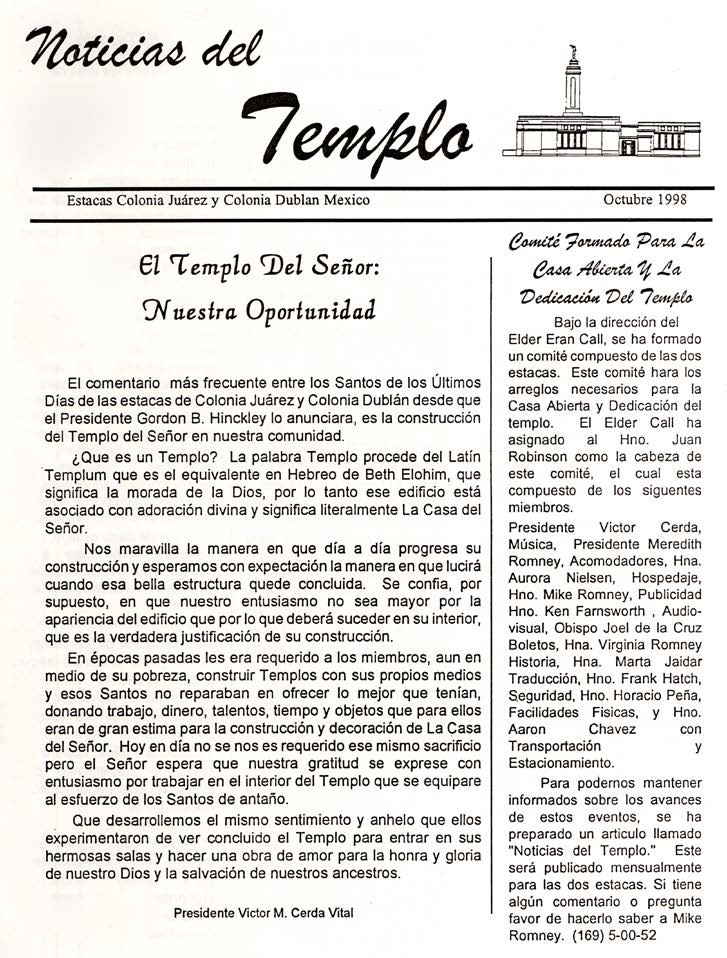 Mike Romney published this monthly newsletter beginning in October 1998.
Mike Romney published this monthly newsletter beginning in October 1998.
To build interest and enthusiasm among the members, Mike Romney began publishing a newsletter called Temple Views. He published it once a month starting in October 1998. Printed in both Spanish and English, it offered news and editorials on the temple, reports of its progress, and explanations of its purpose.
When Meredith Romney was appointed temple president in January 1999, he was released as chairman of the ushers subcommittee, but he agreed to continue as an adviser. David Brown, future mission president and Area Seventy, of Colonia Juárez, was asked to step in and head this key committee.
The temple in Colonia Juárez even attracted national press attention. On February 21, Televisa, a nationwide television service from Mexico City, was on the site filming and taking pictures.
In January, Tom Coburn replaced Jack Purser in the Temple Department at Church headquarters as the local committee’s contact. During the next two months, John Robinson was in contact with him by telephone approximately twice each week going over details related to the upcoming events. The Church’s Public Affairs Department also provided many helpful insights and suggestions for the open house.
The Open House
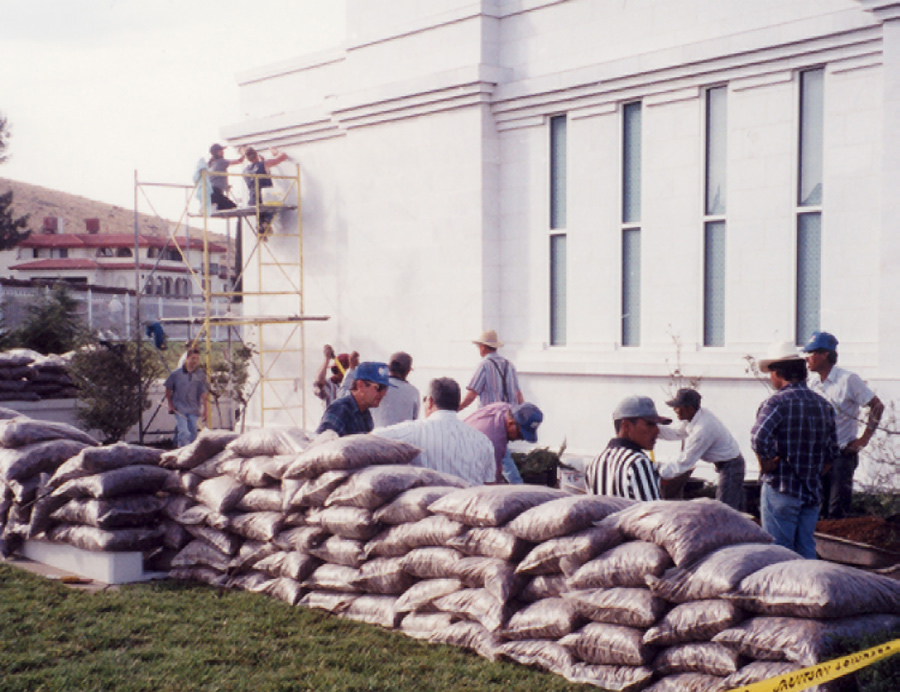 On the evening before the open house, much work remained to be done.
On the evening before the open house, much work remained to be done.
Members of the Colonia Juárez and Colonia Dublán stakes welcomed 10,870 visitors to their temple open house held February 25–27, 1999. Members from throughout both stakes spent many hours helping to get the grounds and other areas of the temple ready for this event.
Adequate publicity was essential to the open house’s success. Mike Romney contacted the media to arrange for coverage. As a result, newspapers in Ciudad Juárez, Nuevo Casas Grandes, and Chihuahua City carried a color insert featuring pictures of the new temple plus articles on the purposes of temples and the history of the Church.
A Ciudad Juárez television station broadcast four different Church videos twice, all at prime time. Despite opposition from some local clergy, the extensive coverage gave a favorable impression of the temple and the Church.
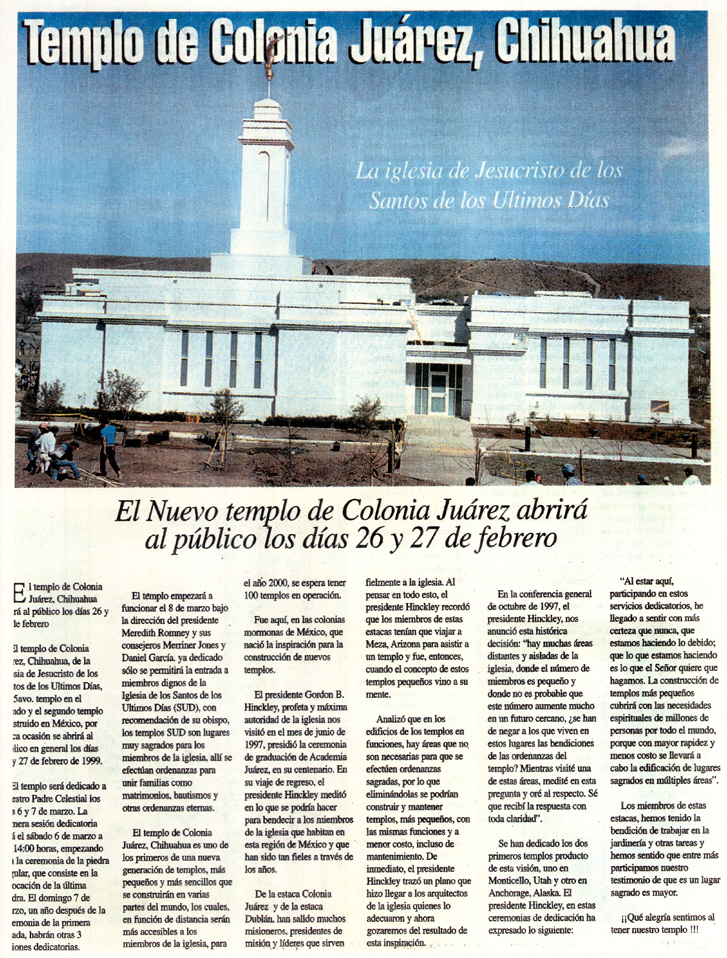 Inserts in local newspapers gave information about the temple.
Inserts in local newspapers gave information about the temple.
Church members also played a key role in getting the word out to friends of other faiths in the area. They helped them understand what a temple is. Many invited their neighbors of other faiths to family home evenings to talk about families and temples. Even children in the Colonia Dublán Stake invited their friends to the temple open house.
Elder Eran Call and his wife, Kay, hosted a special VIP reception and tours on Thursday, February 25. In a press conference held beforehand, President Call spoke to representatives from local newspapers and radio stations. He explained the importance of temples in members’ lives and what they needed to do to become worthy to attend the temple. He briefly discussed the fundamental differences between Latter-day Saint temples and chapels. He also expressed appreciation for what the colonists had done to get the temple and grounds ready. “You are to be commended,” he said. He then made the following formal statement:
What a thrill a few days ago to drive down the dugway into Colonia Juárez at dusk, and see the almost-completed temple which appeared as a “jewel on a hill.” My wife and I remembered the dedicatory prayer which I had offered at the groundbreaking in which those same words, “a jewel on a hill,” had been expressed. Tears of joy came to our eyes. . . .
As we walked through the temple last night, I was in awe by the beauty of every room, especially the celestial and sealing rooms. Certainly it is true what President Hinckley has said, “These small temples will be built with the finest materials and as beautiful as we can make them.” Certainly this is the case with this beautiful temple. All of us are so thrilled with its beauty, both inside and out.
The most beautiful part of the temple is yet to come. When worthy Saints, dressed in white, symbolic of purity and worthiness, enter the temple to do vicarious work for those who have passed on, they sanctify themselves in selfless service for others. That is the great beauty of the temple. What happens inside is the living evidence of our belief that men and women, children of God, are eternal. The real test of how much we love the temple and the Lord is demonstrated by how frequently we attend.[4]
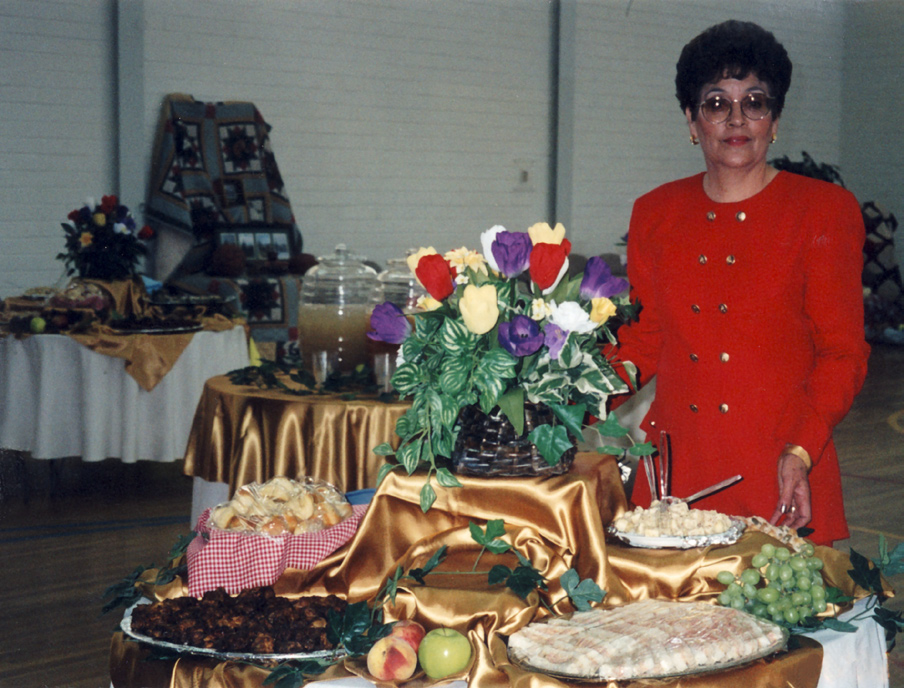 Aurora Nielsen coordinated the VIP luncheon.
Aurora Nielsen coordinated the VIP luncheon.
Approximately 150 religious, government, and business leaders attended this special VIP open house. Elder Call was very personable and helped his guests feel welcome as he conducted four groups on a tour of the temple, explaining in more detail the purpose and sacredness of the new building. He answered questions as he took the groups from one room to another. One guest was concerned about the celestial room’s frosted windows and wondered why the Church wanted to keep people from looking in. Before Elder Call had the chance to explain, an insightful guest of another faith responded, “It isn’t so the people outside can’t see in, it’s for those who are inside who want to keep the world out.” Elder Call agreed, “I couldn’t have said it better.”[5]
Aurora Nielsen, who headed the housing and accommodations subcommittee, arranged food for these special guests. Delicious appetizers, desserts, and candies were served, all prepared by women in the Relief Society.
Among the guests who attended the VIP open house were the former governor of the state of Chihuahua, Francisco Barrio, and his wife, Hortencia. While visiting the temple’s sealing room, Elder Call testified, “We believe that we can be sealed together as husband and wife for time and eternity with our children in the hereafter. We believe in a God who is kind and loving.” He then turned to his wife, Kay, and added, “I can’t imagine that God wouldn’t allow me to be with my wife in the hereafter.” He explained that they had been sealed for eternity in a temple like this.
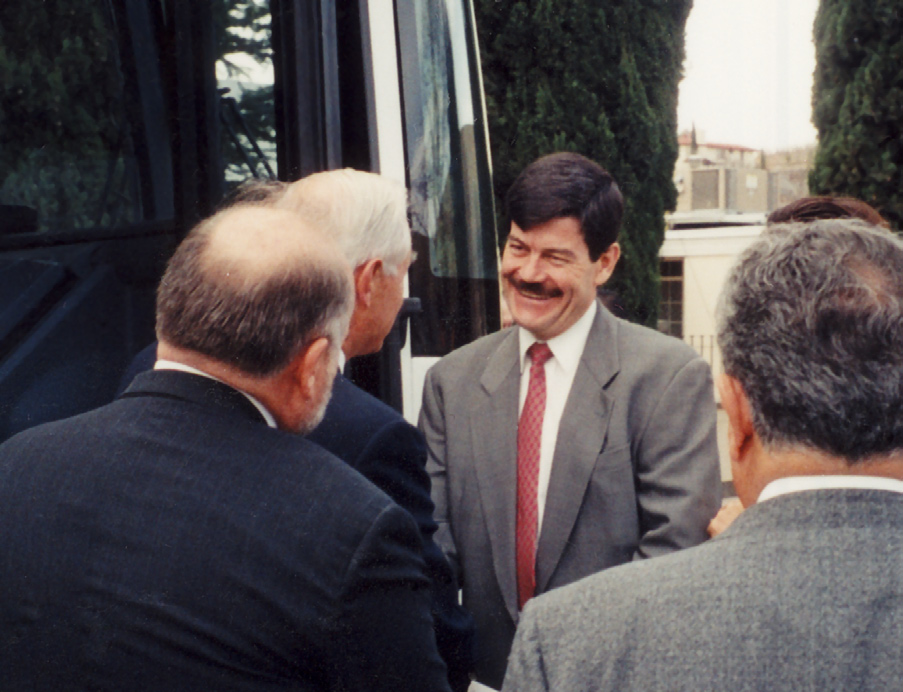 Elder Eran Call welcomes former Chihuahua governor Francisco Barrio to the VIP open house.
Elder Eran Call welcomes former Chihuahua governor Francisco Barrio to the VIP open house.
As the other guests left the room, the Barrios, who had lost two teenage children in recent years, lingered behind and asked, “Mr. Call, do you really believe that you can be with your wife and your children together after this life?”
Elder Call emphatically responded, “I do not believe it; I know it.”
Governor Barrio confided, “Now I understand why all the Mormons I know are a happy, confident, and content people.”[6] In his formal statement after the tour, the governor commented, “The temple is a place which inspires reflection and changes our attitude. It felt wonderful to be inside.”[7]
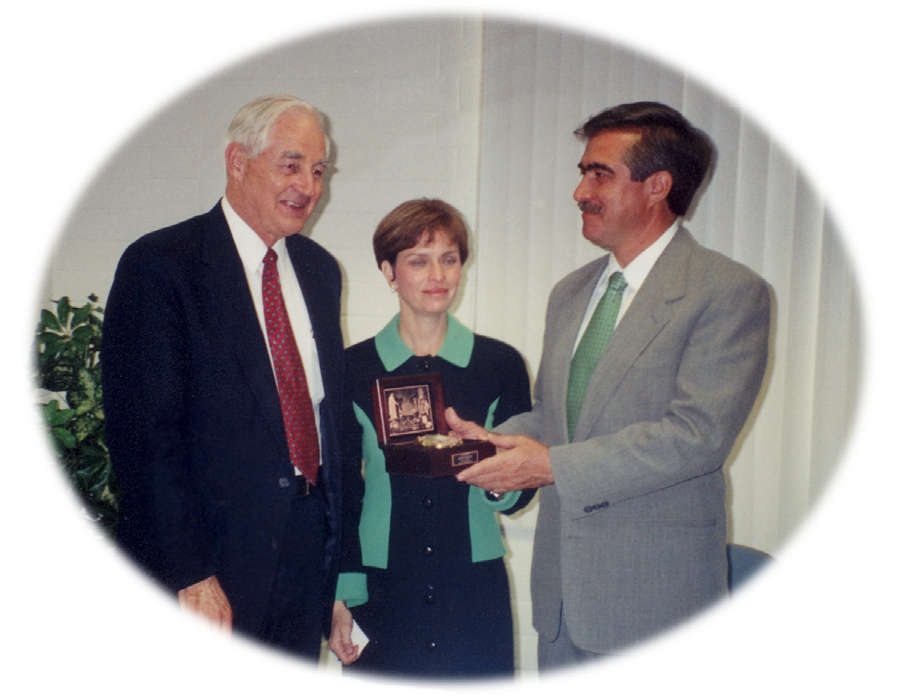 Elder Call presents a gift to Chihuahua governor Patricio Martínez and his wife.
Elder Call presents a gift to Chihuahua governor Patricio Martínez and his wife.
Another guest was the current governor, Patricio Martínez, who had many favorable things to say about the Church, its local members, and the temple. “It has been an extraordinary experience and an honor for my wife and me to have been invited to visit this temple. It is a place that reflects pure joy from the time you walk through the doors until you enter the last beautiful room adorned in crystal and white. We will always consider it an honor for us to have been able to visit this sacred place before it is dedicated. Congratulations to the Church and to all the members in this area who are people worthy of their religious and hardworking inheritance, which has been a part of the land of Chihuahua for more than a century.” In a press conference held after the tour, the governor also recognized the history of sacrifice, hard work, and suffering of the early Saints in the colonies and acknowledged the hand of Christ in their prosperity.[8]
Church members likewise attributed the blessing of a temple in their area to their ancestors’ worthiness. Joyce Dalene from Juárez First Ward affirmed, “I definitely feel that this is a blessing, not because of anything we did, but because of the exemplary lives of our parents and grandparents and great grandparents.” The new president of the Colonia Juárez Stake, Lester Johnson, declared, “Our ancestors must have been tremendous, tremendous people to have built and committed themselves to the point that the colonies are what they are today.”[9] Speaking of the upcoming dedication, President Romney expressed, “It’s going to be a special time. I know that if we could open our spiritual eyes, we would see that there will be more of them than there are of us.”[10]
Mexican congressman Jeffrey Jones, a native of Dublán, also expressed his gratitude for the rich heritage of values instilled in him. He was accompanied by Senator Luis H. Alvarez and his wife, who expressed their admiration for the temple and its significance to the area.
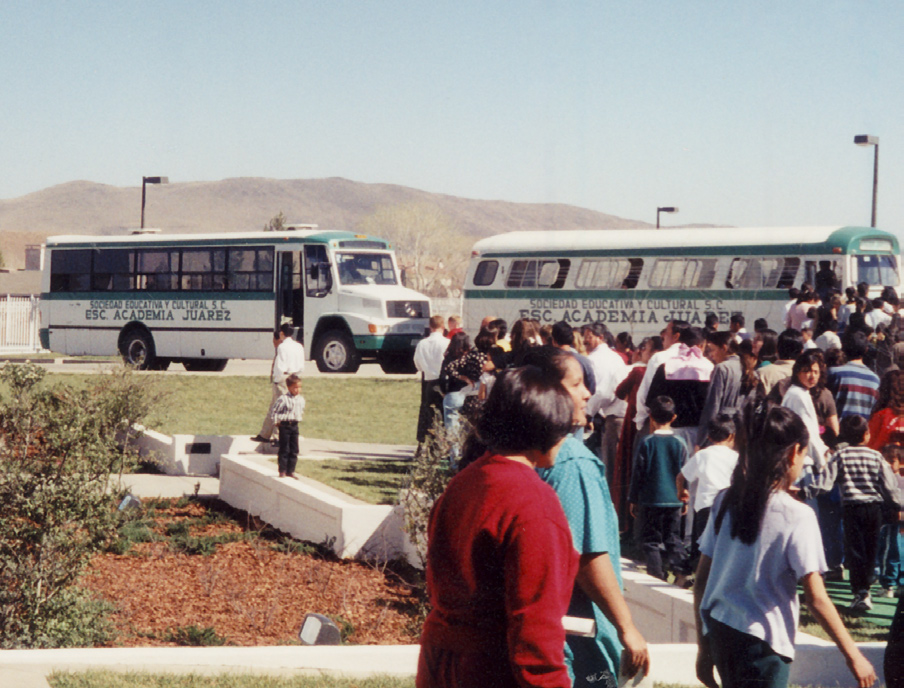 Academy buses take visitors from the stake center up to the temple.
Academy buses take visitors from the stake center up to the temple.
Both Latter-day Saints and members of other faiths flooded the small community during the next two days. The public open house took place on Friday and Saturday, February 26 and 27. Visitors came from all over the state of Chihuahua as well as from Sonora, Durango, Mexico City, and even South America. Guests also arrived from north of the border and from as far away as Europe. Rolf Seljelid and his wife, Gor Folkam, of Norway, happened to be in the area and heard about the open house. “We are here to look at this impressive building, but the other thing is that we feel that we are together with a lot of good people, people who are obviously committed to do a good job in their society. You see the orderliness here, and you see that they are hardworking, and that’s what the world really needs.”[11]
Because there was limited parking immediately around the temple, the tour began at the nearby Colonia Juárez chapel, where visitors viewed a short video prepared by the Temple Department for this occasion. It explained the history and functions of temples and included a statement by President Hinckley explaining their connection to the eternities. Thus they could feel the Spirit even before entering the temple, observed President Victor M. Cerda of the Colonia Dublán Stake.[12] Each visitor received a pamphlet with pictures of the new temple and information about temple service in general.
Approximately forty people gathered in each of the video presentations before boarding Juárez Academy buses that took them up the newly constructed road to the top of the hill, where they were welcomed into the beautiful temple. Faced with marble from Torreón, the temple was a brilliant white. Before the visitors entered the building, local youth helped them put plastic covers over their shoes to protect the interior of the temple. One three-year-old called them “magic shoes.”[13] Inside, they walked through on a silent tour. Printed signs indicated the purpose of each room. Visitors saw furnishings carefully selected to create a subtle air of Old Mexico. Carpet runners were placed along the route of the tours to protect the temple’s floor coverings.
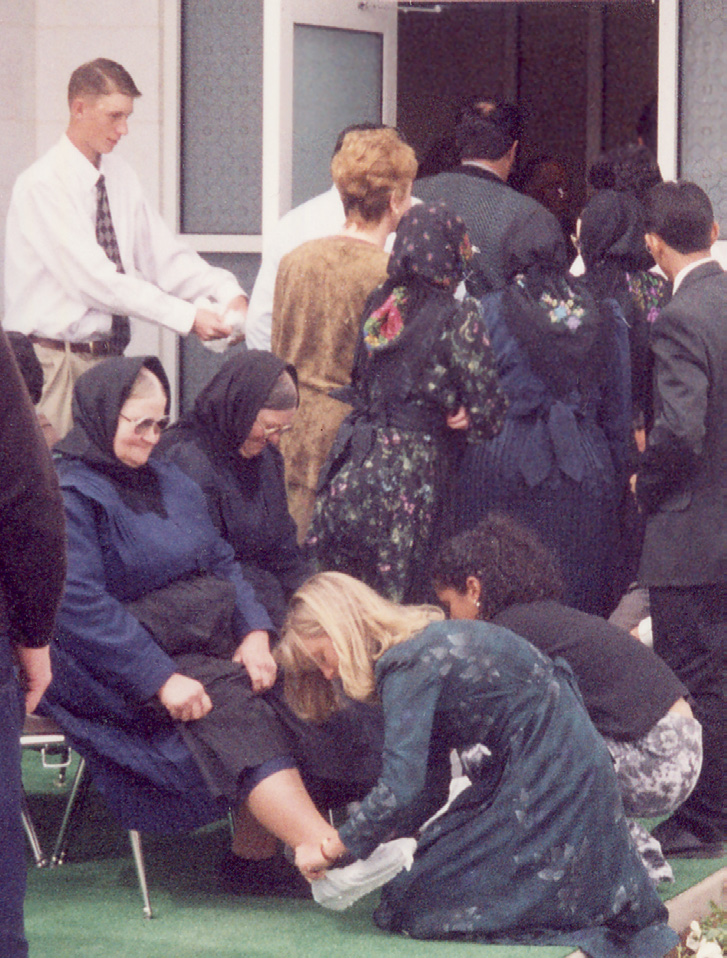 Youth assist visitors to put plastic coverings over their shoes before entering the temple.
Youth assist visitors to put plastic coverings over their shoes before entering the temple.
Ushers for this event included high councilors and bishops, their wives, and other members from both stakes. Training sessions had instructed them in their duties. “The objective was to keep people moving in an orderly fashion as we strove to help them feel welcome and enjoy their temple experience,” summarized David Brown, chairman of the ushers subcommittee. Ushers facilitated the movement from the parking lot, through the chapel, on and off the buses, and through the temple. Thirty adults were assigned to each four-hour shift, plus twelve youth who helped the visitors with their shoe coverings.[14] The Church’s Public Affairs Department instructed that the open house not be used to proselyte; therefore missionaries were stationed just outside only to answer questions about the temple.
Two thousand visitors toured the temple on Friday, while over eight thousand came the following day. When quite a bottleneck developed on Saturday, with people waiting in line up to an hour, a second room was opened to show the video. This helped to shorten the lines. At one point the suggestion was made to take the groups directly up to the temple without seeing the introductory film, but leaders felt that each visitor should see the video and feel its spirit. This was an uplifting experience for those coming to see the temple, and there were no complaints about waiting in line so long.[15]
Those who visited the temple were impressed with the elegance of the building. Some typical comments included: “It’s truly spectacular.” “The details!” “It went far beyond our expectations.”[16] One member from Nuevo Casas Grandes First Ward, Ana Molina García Ontiveros, said, “I couldn’t believe that in one year we could have a temple built here in Mexico that was so beautiful.”
Spiritual Impact of the Temple
“Many were visibly touched by the Spirit as they toured the temple and contemplated the eternal truths that were introduced,” observed Committee Chairman Robinson. “Some would stay in the temple extra time just soaking up the beauty and the Spirit that was ever present in the temple. Many hearts were touched as they felt the sweet influence of the Holy Ghost.”[17]
On Friday evening when the last visitors were taken back down to the chapel, Arturo Cordova, not a member of the Church, was waiting there. He asked the guides if they couldn’t take him and his out-of-town friends on a tour. “We should have been tired,” Brother Robinson admitted, “but we were so excited about the temple and the special feeling there that we loaded them on the bus and took them up for a tour. They were very appreciative and visibly moved by the experience.” Señor Cordova described how he had a warm feeling while in the temple and asked his Latter-day Saint friend, Ron Dalene, what it was. “It was the Holy Ghost that was testifying that this was the Lord’s house,” Ron replied. [18]
Margie Quevedo, also a member of another faith from Dublán, warmly recalled, “The temple is just gorgeous. It is just beautiful. It’s impressive. It’s celestial. I didn’t really have any expectations because I don’t have any experience in Mormon temples. It’s very serene, very tranquil. It is more beautiful than I expected. Coming into town I was mentioning to my friends that you can feel the emotion, the love emanating from everybody here. Everyone radiates love, especially the members of the Mormon Church. It’s just overflowing with it.”[19]
Some of the youth who were assisting visitors with their shoe covers noticed that the people were visibly touched. “Many did not speak after exiting the temple; they continued to maintain a spirit of reverence even on the temple grounds, and many were still wiping tears from their eyes as they left.”[20]
The overwhelming and peaceful spirit upon stepping through the temple doors was unfamiliar to some. “I’ve never felt that way before,” guests of other faiths later said to their Latter-day Saint friends. “I had no idea it would be like that. It was just an indescribable feeling.” They were told that this feeling was the Spirit of the Lord. President Romney explained the reason the Spirit was so strong during the open house: “Even though the temple hasn’t been dedicated, the site has. The house of the Lord is on sacred ground.”
As many were invited to look into the sealing room mirrors during the temple open house, they saw their families’ eternal reflection. This was a time for contemplation. Sister Delia Marquez González from the Obrera Ward in Nuevo Casas Grandes remarked, “It is so special to know that we are living not for today or tomorrow but for the eternities with our families and all of our loved ones. It means a lot to me to have the temple here because I can return often and feel of the love God has for me, His daughter. Just like our family saw our reflection in the mirrors, I know and feel that we will be together forever if we keep all the covenants of the temple.”[21]
Members were anxious for temple work to begin. Members had postponed weddings until their temple could be completed. Others had waited for over a year to be sealed to their families. Javier Quezada from the Nuevo Casas Grandes Second Ward and his wife, Sandra, joined the Church in January 1997 with their children, Adriana, Austin, and Kevin. They had the opportunity to go to the Mesa temple or even Mexico City to be sealed a year later, but when they heard the announcement of the Colonia Juárez temple, their family chose instead to patiently wait until their own temple could be dedicated. An emotional Sandra Quezada expressed her feelings soon after going through the temple open house. “When we were baptized I felt a very special feeling which I felt again today. I want to be sealed in this temple.” They were sealed as a family, which was fortunate because Javier died not long afterwards.
Colonia Juárez Second Ward member, Piti Zelaya, who had recently lost her teenage son, appreciated the Lord’s house. “The temple allows me to have a place to go and talk to Heavenly Father and receive His comfort.”[22]
Members of both stakes were continually admonished by their leaders to put their lives in order as they prepared for the dedication of the temple. Colonia Juárez First Ward bishop Rick Turley expressed the changes he had noticed in his ward members: “[The temple] has created an amazing awareness of where we stand in righteousness. I’ve seen where so many members have taken steps to change even the little things in their lives that are often overlooked to prepare themselves for the temple here.”
Bishop Pedro Vazquez from the Obrera Ward reported, “I have definitely noticed an increase in ward attendance. We are anxiously preparing ourselves to enter the Lord’s sacred house.” Dublán First Ward bishop Chris Bowman had a similar impression: “I’ve seen an increase of love among the members and an increase of faith for the gospel and temple work.”[23]
President Lester Johnson hoped it would be a time for members of both stakes to recommit themselves and reprioritize their lives so they would be able to spend the time necessary to accomplish the temple’s designs—to do the work for their ancestors.[24]
Elder David E. Sorensen of the Seventy and chairman of the Church Temple Department was in the area to reorganize the Colonia Juárez Stake presidency. He said:
This is a remarkable event that has come to this part of Mexico. I think that this is a special site that will bless not only this valley, but all the surrounding valleys. This seems to me that the prophet of the Lord has been inspired to choose this unique spot to overlook this community. I feel the power and spirit of Elijah as I stand here and contemplate the sacrifice and the faith and the devotion of Latter-day Saints who live here. I take my hat off to them. I salute them for their faithfulness, for their devotion to this great cause. I feel so pleased that the Lord would see fit to have our prophet, this great temple builder of the dispensation of the fulness of times, declare that this is the spot to have one of His holy houses. I know it will bless the entire community and all who live within a reasonable distance of this sacred place.[25]
With the conclusion of the open house Saturday evening, February 27, attention turned to final preparations for the temple’s dedication just a week later. As members planned for the thousands expected to arrive for the dedicatory sessions, their thoughts turned to their faithful ancestors who had laid a foundation of faith and whose presence they hoped to feel at the time of dedication.[26]
Notes
[1] Debra Spilsbury, “New Temple ‘a Dream’ to LDS in Northern Mexico,” Church News, March 6, 1999, 3.
[2] John Robinson, “Local Chairman/
[3] Robinson, “Local Chairman,” in Romney, History, 2:399.
[4] Eran Call, in Romney, History, 2:264.
[5] Romney, History, 2:259.
[6] Eran Call, interview by Richard Cowan, November 25, 2007.
[7] Fransisco Barrio, in Romney, History, 2:259–60.
[8] Patricio Martínez, in Romney, History, 2:260; see also Spilsbury, “New Temple,” 3, 6.
[9] Lester Johnson, in Romney, History, 2:260.
[10] Meredith Romney, in Romney, History, 2:262.
[11] Rolf Seljelid and Gor Folkham, in Romney, History, 2:260.
[12] Victor M. Cerda, “Music and Member/
[13] Spilsbury, “New Temple,” 6.
[14] David Brown, “Ushers,” in Romney, History, 2:409–10.
[15] Robinson, “Local Chairman,” in Romney, History, 401.
[16] Spilsbury, “New Temple,” 6.
[17] Robinson, “Local Chairman,” 401.
[18] Robinson, “Local Chairman,” 401.
[19] Margie Quevedo, in Romney, History, 2:260–61.
[20] Spilsbury, “New Temple,” 6; much of the information in the following paragraphs was also taken from Debra Spilsbury’s account of the open house, prepared for Romney, “History.”
[21] Delia Marquez González, in Romney, History, 2:261.
[22] Spilsbury, “New Temple,” 6.
[23] Chris Bowman, in Romney, History, 2:261–62.
[24] Romney, History, 2:262.
[25] David E. Sorensen, in Romney, History, 2:261–62; see also Spilsbury, “New Temple,” 6.
[26] Romney, History, 2: 261–62.
